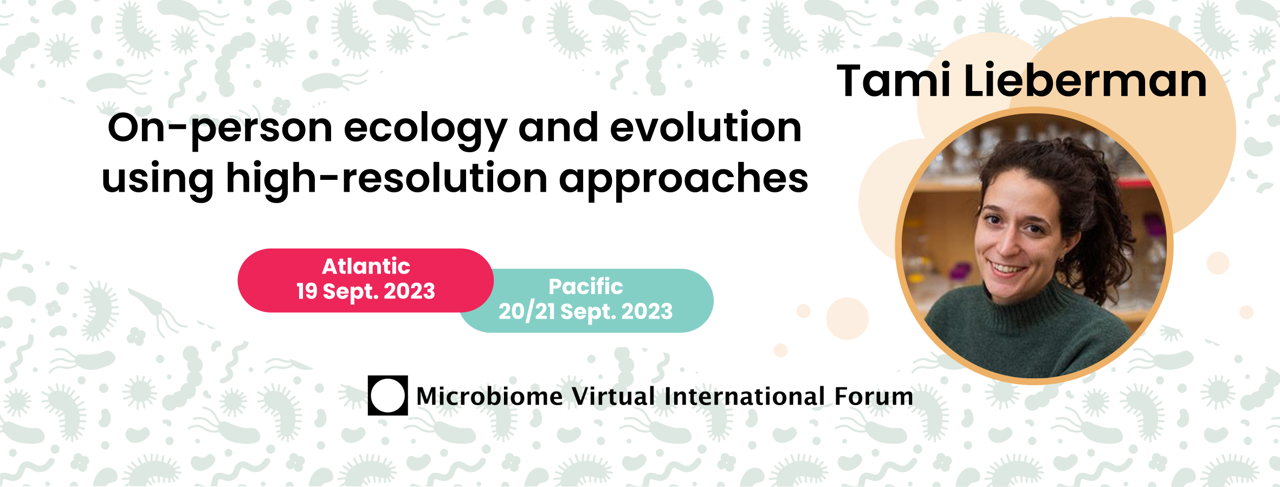On-person ecology and evolution using high-resolution approaches
By prof. Tami Lieberman
Short Bio
Prof. Tami Lieberman is an Associate Professor at MIT, where she is jointly appointed in the Institute for Medical Engineering and Science and the Department of Civil and Environmental Engineering. Prof. Lieberman completed her PhD in Systems Biology from Harvard University in Roy Kishony’s laboratory. As a postdoc in Eric Alm’s laboratory at MIT, she discovered the first evidence that bacteria in the gut microbiome acquire adaptive point mutations during health. She is a recipient of the NIH Director’s New Innovator Award.
The Lieberman Lab develops computational and experimental techniques to understand how commensal bacteria evolve on the skin of individual people and across the globe. Microbial-based therapies remain difficult to design, and we cannot predict which strains will stably colonize an individual. Dr. Lieberman’s group seeks to close this knowledge gap and develop mechanistic understanding of how strains behave in human microbiomes—including selective pressures they face, their niche ranges and survival strategies, and the degree to which they adapt within individual microbiomes.
Professor Lieberman’s mail and twitter profile
Selected Talks
Advances in cpn60 barcoding for microbial species identification
The “universal target” region of the gene encoding the 60 kDa chaperonin protein (cpn60, also known as groEL or hsp60) is a proven sequence barcode for bacteria and a useful target for marker gene amplicon-based studies of complex microbial communities. Application of cpn60 barcode sequencing is facilitated by 'universal' amplification primers and cpnDB, a manually curated reference database of cpn60 sequences. Recent developments to the cpn60 platform include demonstration that 150 bp from the 5' end of the barcode is sufficient for species level resolution of bacteria. These short sequences can be identified using established sequence classifiers (QIIME2 feature classifier and RDP classifier), making it simple to integrate cpn60 amplicon sequence identification into existing microbiome analysis pipelines, as recently demonstrated for human skin, vaginal, salivary and stool microbiomes. The purpose of this presentation is to provide a brief overview of cpn60 barcoding resources and applications, and to highlight recent research advances.
Link to OA paper: https://www.nature.com/articles/s43705-023-00283-z
University of Saskatchewan, Canada
An efficient method for high molecular weight bacterial DNA extraction suitable for shotgun metagenomics from skin swabs
The human skin microbiome represents a variety of complex microbial ecosystems that play a key role in host health. Molecular methods to study these communities have been developed but have been largely limited to low-throughput quantification and short amplicon-based sequencing, providing limited functional information about the communities present. Shotgun metagenomic sequencing has emerged as a preferred method for microbiome studies as it provides more comprehensive information about the species/strains present in a niche and the genes they encode. However, the relatively low bacterial biomass of skin, in comparison to other areas such as the gut microbiome, makes obtaining sufficient DNA for shotgun metagenomic sequencing challenging. Here we describe an optimised high-throughput method for extraction of high molecular weight DNA suitable for shotgun metagenomic sequencing. We validated the performance of the extraction method, and analysis pipeline on skin swabs collected from both adults and babies. The pipeline effectively characterised the bacterial skin microbiota with a cost and throughput suitable for larger longitudinal sets of samples. Application of this method will allow greater insights into community compositions and functional capabilities of the skin microbiome.
Link to OA paper: https://www.microbiologyresearch.org/content/journal/mgen/10.1099/mgen.0.001058
Iliana Rosa Serghiou - mail
Quadram Institute of Biosciences, UK
Highlights
Comparative Genomic and Metagenomic Investigations of the Corynebacterium tuberculostearicum Species Complex Reveals Potential Mechanisms Underlying Associations To Skin Health and Disease
Corynebacterium are a diverse genus and dominant member of the human skin microbiome. Recently, we reported that the most prevalent Corynebacterium species found on skin, including Corynebacterium tuberculostearicum and Corynebacterium kefirresidentii, comprise a narrow species complex despite the diversity of the genus. Here, we apply high-resolution phylogenomics and comparative genomics to describe the structure of the C. tuberculostearicum species complex and highlight genetic traits which are enriched or depleted in it relative to other Corynebacterium. Through metagenomic investigations, we also find that individual species within the complex can associate with specific body sites. Finally, we discover that one species from the complex, C. kefirresidentii, increases in relative abundance during atopic dermatitis flares, and show that most genomes of this species encode a colocalized set of putative virulence genes.
Link to OA paper: https://journals.asm.org/doi/10.1128/spectrum.03578-22
Rauf Salamzade - mail, twitter
University of Wisconsin - Madison, USA
Gut microbiome modulates tacrolimus pharmacokinetics through the transcriptional regulation of ABCB1
Background. Following solid organ transplantation, tacrolimus (TAC) is an essential drug in the immunosuppressive strategy. Its use constitutes a challenge due to its narrow therapeutic index and its high inter- and intra- pharmacokinetic (PK) variability. As the contribution of the gut microbiota to drug metabolism is now emerging, it might be explored as one of the factors explaining TAC PK variability. Herein, we studied the contribution of the gut microbiota to TAC PK, using a combination of in vivo and in vitro models. Results. TAC oral administration was performed in mice. Compared to controls, mice with a lower intestinal microbial load due to antibiotics administration exhibit a 33% reduction in TAC whole blood exposure and a lower inter-individual variability. This reduction in TAC levels was strongly correlated with higher expression of the efflux transporter ABCB1 (also known as the p-glycoprotein (P-gp) or the multidrug resistance protein 1 (MDR1)) in the small intestine. Conventionalization of germ-free mice confirmed the ability of the gut microbiota to downregulate ABCB1 expression in a site-specific fashion. The functional inhibition of ABCB1 in vivo by zosuquidar formally established the implication of this efflux transporter in the modulation of TAC PK by the gut microbiota. Furthermore, we showed that polar bacterial metabolites could recapitulate the transcriptional regulation of ABCB1 by the gut microbiota, without affecting its functionality. Finally, whole transcriptome analyses pinpointed, among others, the Constitutive Androstane Receptor (CAR) as a transcription factor likely to mediate the impact of the gut microbiota on ABCB1 transcriptional regulation. Conclusions. We highlight for the first time how the modulation of ABCB1 expression by bacterial metabolites results in changes in TAC PK, affecting not only blood levels but also the inter-individual variability. More broadly, considering the high number of drugs with unexplained PK variability transported by ABCB1, our work is of clinical importance and paves the way for incorporating the gut microbiota in prediction algorithms for dosage of such drugs.
Link to OA paper: http://dx.doi.org/10.1186/s40168-023-01578-y
Alexandra Louise Degraeve - mail, twitter
Louvain Drug Research Institute, UCLouvain, Belgium
Minimizing Bias in Microbiome Research
Sponsored Highlight by QIAGEN
Elly Sinkala
Microbiome Science for Everyone: MVIF season 1&2
The Microbiome Virtual International Forum (MVIF) is a substitute for multi-day microbiome conferences. MVIF was created by microbiome scientists with intent to be free, beneficial, and convenient for scientists all over the world, no matter their career stage. The MVIF creators are hoping to make the event as productive as possible. Therefore, in this NSURP2023 project (https://nsurp.org/), my aim was to compare MVIF Season 1 and MVIF Season 2 by compiling speakers’ information from https://www.microbiome-vif.org/en-US/-/past-events and documenting it in a Google Sheet. I hypothesized that there would be a few differences between the seasons in some aspects of the past MVIF events. The speakers’ metadata was analyzed using Python libraires: pandas, numpy and matplotlib. The results showed that there were a total of 142 speakers with 53% being females and the remaining 47% being males. For both seasons, most of the speakers’ affiliated locations were the USA and European countries and their talks focused on the human gut and bioinformatics. I was able to see a difference between the two seasons: Season 1 had a total of 82 speakers (with consequently a higher number of talks) whereas Season 2 had 60 speakers. Although season 1 had more diverse microbiome topics, in Season 2 there’s a slight increase in non-human microbiome topics, such as water microbiome. From September, there will be a new season with an effort to amplify more diverse voices of microbiome science.
Shanya Taylor
NSURP Mentee
University of the Virgin Islands, USA

